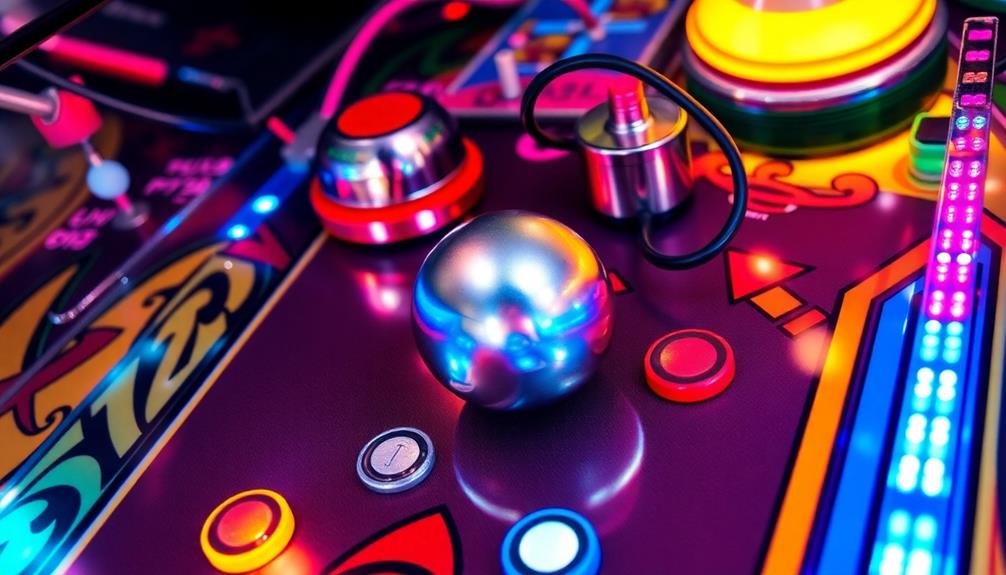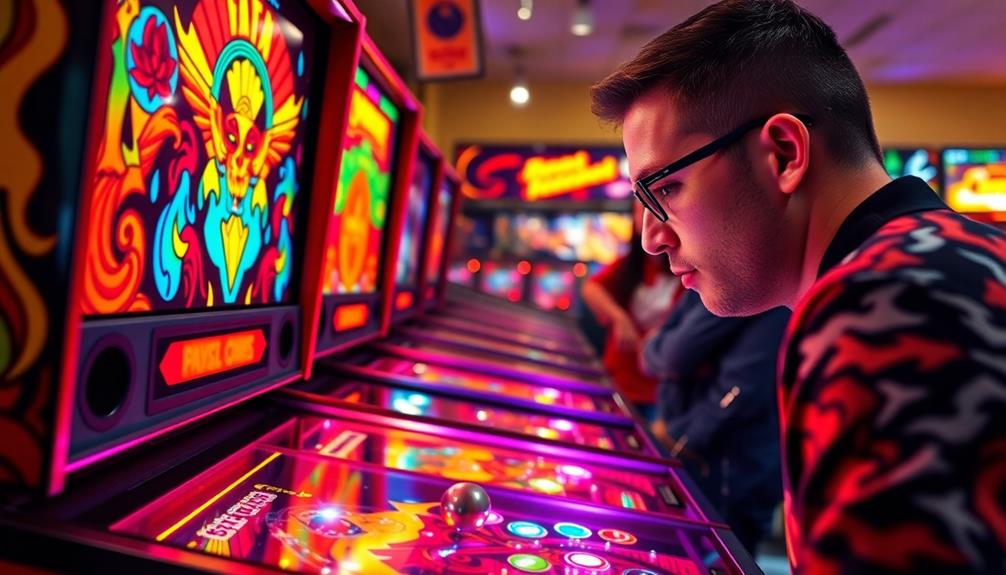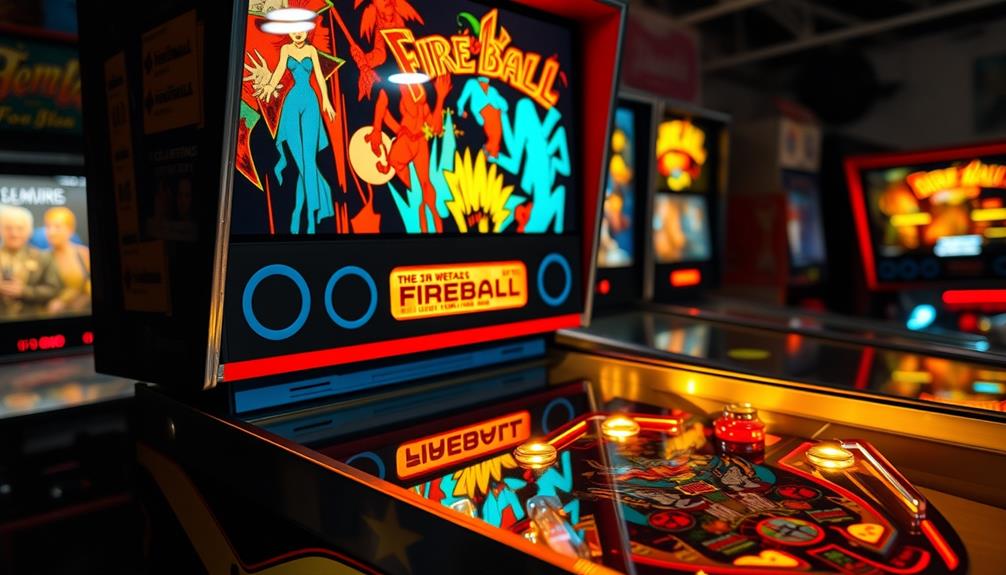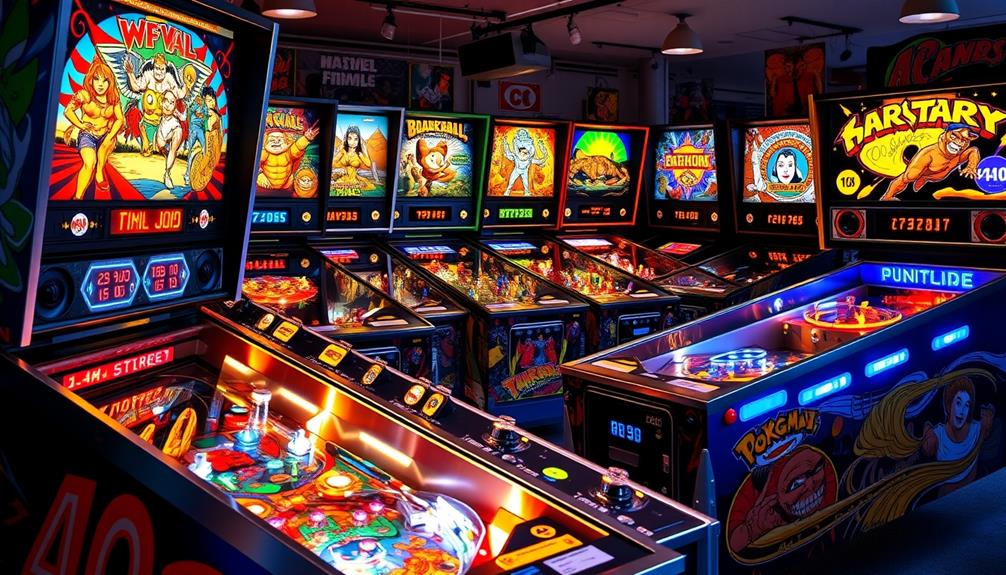A pinball machine operates using a combination of mechanical parts and electronics. When you pull the plunger, it propels the ball onto a sloped playfield designed for seamless gameplay. You manipulate the ball with flippers, aiming at targets to earn points and activate bumpers for unexpected rebounds. The machine keeps track of your score through a dot-matrix display, while the tilt mechanism ensures fair play by preventing excessive shaking. Each game involves a mix of skill and luck, making it an exciting challenge. If you’re interested in learning more about how these components have evolved over time or the future of pinball, there is much to explore. Pinball machine parts have undergone changes over the years, with older machines relying more on mechanical parts and newer models incorporating advanced electronics. The design of the playfield, flippers, bumpers, and targets all play essential roles in creating an immersive and competitive game. As technology continues to advance, it is fascinating to see how pinball machines will innovate and introduce new features while still preserving the classic charm of the game.
Key Takeaways
- Pinball machines feature a tilted playfield and use a plunger to launch the ball, initiating gameplay.
- Flippers allow players to control the ball, redirecting it towards targets for scoring opportunities.
- Bumpers and ramps create unpredictable interactions, enhancing gameplay dynamics and scoring potential.
- The electronic system, including a main controller and dot-matrix display, tracks scores and manages game functions.
- A tilt mechanism ensures fair play by preventing excessive shaking, promoting responsible gameplay.
Overview of Pinball Mechanics
When you step up to a pinball machine, you're diving into a world of intricate mechanics that make each game unique. The playfield, inclined at about 6-7 degrees, guides the ball's movement, adding an exciting challenge to your gameplay. Many modern machines have incorporated advanced technology features that enhance the gaming experience, making them appealing for both casual and serious gamers. These machines are meticulously designed, with every bumper, flipper, and ramp positioned to create a blend of skill-based gameplay and unpredictable outcomes. The optimal pinball machine angle, typically around 6-7 degrees, is crucial to maintaining the perfect balance between speed and control, ensuring the ball doesn’t move too slowly or too quickly. This precise angling, combined with vibrant lights and sound effects, immerses players in an adrenaline-filled experience that’s hard to replicate.
You start by launching the ball using a plunger or solenoid mechanism, sending it careening across the playfield. As the ball rolls, you'll use flippers to keep it in play while aiming for various targets. Each hit can trigger scoring opportunities, activating bumpers and ramps that boost your points. The electronic dot matrix display tracks your scoring, showing real-time updates and gameplay hints to enhance your experience.
However, watch out for the tilt mechanism! It's designed to prevent excessive shaking of the machine, which could unfairly influence the ball's trajectory. If you tilt too much, the game ends, so keep your cool.
Every interaction between the ball, flippers, and targets creates a dynamic experience, making each game of pinball not just a test of skill but a thrilling adventure of strategy and timing.
Key Components of Pinball Machines
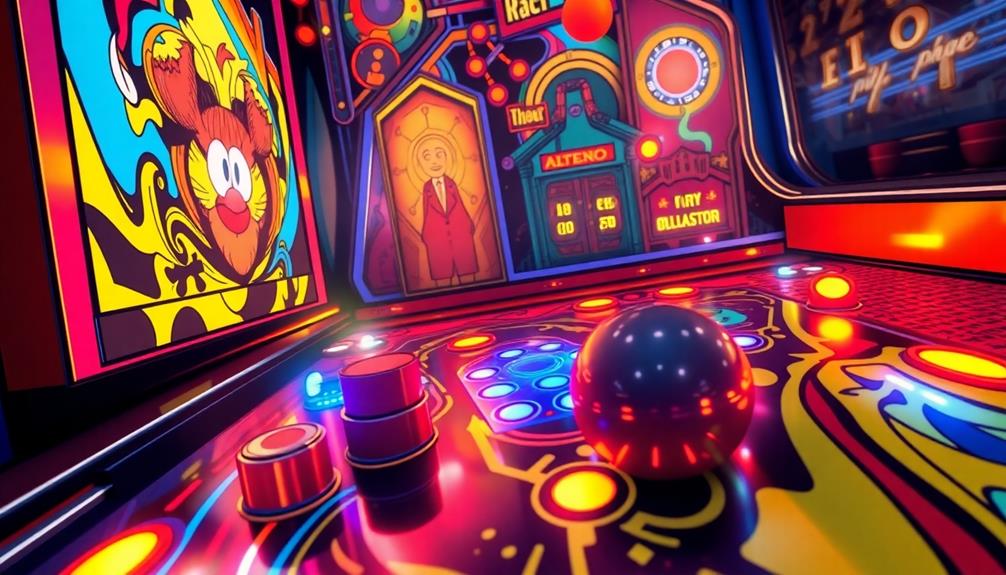
To truly appreciate pinball machines, you need to understand their key components. From the essential mechanical parts like the playfield and flippers to the electronic systems that track your score, each element plays a crucial role in gameplay.
The mechanics of these machines have evolved considerably over the years, particularly with the introduction of electronic scoring in the 1970s, which enhanced the overall experience and complexity of the game technological advancements in pinball.
Let's break down how these parts work together to create the thrilling experience you enjoy.
Essential Mechanical Parts
Five key components make up the essential mechanical parts of a pinball machine, each playing a crucial role in gameplay.
The playfield is where the action happens, tilted at about 6-7 degrees to guarantee the ball rolls smoothly. This design is part of the advanced technology that contributes to the excitement of modern machines, which are often regarded as best rated pinball machines of 2024.
At the bottom of the playfield, you'll find flippers, which you control with buttons to redirect the ball and keep it in play, preventing it from draining.
Scattered across the playfield are bumpers, round knobs that propel the ball upon contact, adding excitement and dynamic interactions to your game.
Above the playfield, the backbox houses the scoring display and main electronics, showcasing artwork that aligns with the game's theme to draw you in.
The coin acceptor signals the machine's computer when you insert a coin, giving you the chance to start your game.
Finally, the plunger is a spring-loaded mechanism that launches the ball onto the playfield, setting the entire game in motion.
Each of these mechanical parts works together to create the thrilling experience that makes pinball machines so engaging.
Electronic System Functions
Pinball machines typically rely on a sophisticated electronic system to enhance gameplay and player interaction. At the heart of this system is the main controller board located inside the machine, which connects and manages all electromechanical components. When you insert a coin, the coin acceptor tells the computer to register credits, allowing you to start the game. This holistic SEO approach reflects the integration of various elements that work together seamlessly, much like the components of a pinball machine.
As you play, the tilt mechanism keeps the ball from going out of bounds. If you shake the machine too much, it triggers a warning or even ends the game to guarantee fair play. The score is kept on a dot-matrix display board, showing your points and providing gameplay hints to keep you engaged.
Wiring in pinball machines can exceed half a mile, linking various components and enabling commands back and forth between the controller and the electromechanical bumpers and flippers. This intricate system guarantees that when you hit the bumpers, you receive points, making every move count.
The playfield is secured physically with screws, ensuring everything stays in place as you enjoy the thrilling experience of pinball.
Gameplay Interaction Dynamics
While you engage with a pinball machine, the dynamic interaction between the ball and key components—such as flippers, bumpers, and ramps—creates an exhilarating experience.
The design of the playfield, typically inclined at 6-7 degrees, enhances ball movement and employs gravity-driven dynamics to keep the gameplay exciting. This interplay of elements can be likened to fostering a culture of innovation where every component plays a critical role in enhancing the overall experience.
Key components that contribute to this thrilling experience include:
- Flippers: These allow you to redirect the ball and prevent it from draining, giving you more control.
- Bumpers: Strategically placed, they propel the ball upon contact, adding unpredictability and creating scoring opportunities.
- Ramps: These guide the ball to higher areas of the playfield, often leading to bonus points.
- Backbox: Houses the electronics and displays your current scores, integrating a seamless gaming experience.
As the ball interacts with these elements, you'll notice how each bounce and redirect influences the flow of gameplay.
The combination of electronic and mechanical components works together to create a cohesive experience, making every session unique and engaging.
Enjoy the thrill of mastering the dynamics of your pinball adventure!
Gameplay and Scoring Systems
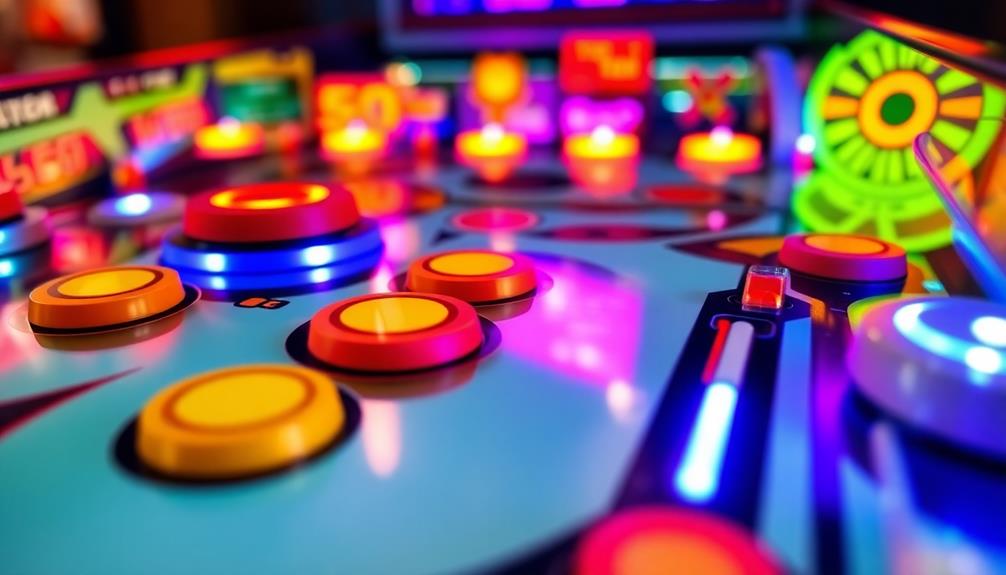
Many players find the gameplay and scoring systems of pinball machines both engaging and strategic. A key feature is the dot matrix display, which shows your current score and highlights scoring opportunities. To maximize points, experienced players often focus on hitting specific targets to activate jackpots and bonuses.
Here's a breakdown of various gameplay elements:
| Gameplay Element | Description |
|---|---|
| Scoring Mechanics | Points awarded for hitting targets |
| Multi-ball Modes | Allows multiple balls in play, increasing score potential |
| Replay Value | Rewards for achieving top score thresholds |
| Free Games | Earned by hitting special scoring marks |
| Jackpots | Activated by completing specific shots |
Tilt Mechanism and Match Feature
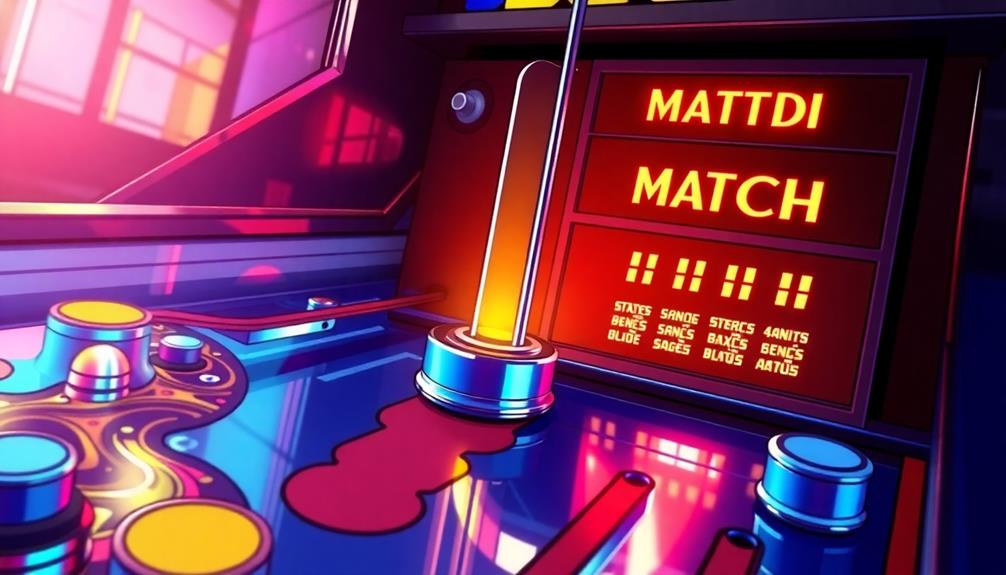
In a pinball machine, the tilt mechanism plays an essential role in ensuring fair play by monitoring excessive shaking. This mechanism is important for maintaining the integrity of the game, as it prevents players from gaining an unfair advantage through physical manipulation.
If you shake the machine too much, the tilt sensor will trigger warnings or even end your game.
Plus, the match feature adds an exciting twist, letting you potentially score a free game by matching your final digits, but don't count on it too much!
Tilt Sensor Functionality
How does the tilt sensor enhance your experience in a pinball machine? The tilt sensor is essential for maintaining fair gameplay, ensuring that you can't gain an unfair advantage by shaking or abusing the machine.
It consists of a metal ring and a pendulum bob; when the bob contacts the ring due to excessive movement, it registers a tilt. This leads to:
- Two warnings before gameplay halts
- Immediate game termination for extreme abuse (slam tilt)
- Encouragement to play responsibly
- A balanced challenge with the match feature
Additionally, many pinball machines incorporate unique themes and designs, similar to the engaging experiences found at water parks which create an immersive environment.
The match feature adds another layer of excitement by randomly generating a two-digit number at the end of your game. If the last two digits of your player score match this number, you score a free game! However, with a typical probability of just 7% or less, it keeps the thrill alive without being too predictable.
The combination of the tilt sensor and match feature not only balances skill and chance but also encourages you to engage with the machine in a responsible manner, enhancing your overall pinball experience.
Match Feature Mechanics
The match feature adds another layer of excitement to your pinball experience, working hand in hand with the tilt mechanism to keep gameplay fair and engaging. At the end of your game, the machine randomly selects a two-digit number (00-90). If the last two digits of your player's score match this number, you snag a free game—though the chances of this happening are usually 7% or less.
Understanding the mechanics of chance and fairness in games can enhance your overall experience, much like how emotional regulation plays a role in managing borderline personality disorder.
The tilt mechanism plays a vital role in this process. It consists of a metal ring and a pendulum bob that hangs freely. If you shake the machine excessively, the bob can hit the ring, triggering a tilt.
Newer pinball machines often give two warnings before this leads to game termination, reminding you to balance aggressive gameplay with caution. Remember, there are different types of tilts: standard tilts occur with moderate shaking, while slam tilts result from extreme actions like lifting or kicking the machine.
These mechanisms guarantee fair play, preventing any manipulation of the machine's position that could give you an unfair advantage. So, keep your gameplay skills sharp, and enjoy the thrill of the match feature!
Fair Play Principles
At the heart of every pinball machine lies a commitment to fair play, embodied through the tilt mechanism and match feature. The tilt mechanism works with a metal ring and pendulum bob, guaranteeing the integrity of the game. If you shake the machine excessively, the tilt sensor triggers a warning. You get two warnings before a standard tilt costs you the ball, while extreme shaking leads to immediate game termination.
This concept of integrity is similar to maintaining a credit score, which plays a vital role in financial health.
These principles help maintain fair competition and enhance your gameplay experience by balancing skill and chance. The match feature adds an exciting twist, randomly selecting a two-digit number at the game's end. If your score matches that number, you earn a free game, usually with a low probability of 7% or less.
Key elements of fair play include:
- The tilt mechanism discourages manipulation.
- The tilt sensor helps maintain game integrity.
- Players can experience both skill and chance.
- The match feature offers a reward for luck.
Together, these features guarantee that pinball remains a thrilling and fair challenge for everyone involved.
Historical Evolution of Pinball

Since the release of "Humpty Dumpty" in 1947, pinball has undergone a remarkable evolution, transforming from simple outdoor games into the complex machines that are familiar to us today.
The journey began with early pinball machines, which evolved from outdoor games like bocce and garden bowling. These shifted into indoor versions, paving the way for modern pinball. This shift reflects a broader cultural change towards indoor entertainment, highlighting the importance of philosophical exploration in the evolution of leisure activities.
Gottlieb played a pivotal role in this evolution. The introduction of "Baffle Ball" in the 1930s marked the first successful coin-operated pinball machine, selling for just $17.50. Then came "Humpty Dumpty," which revolutionized gameplay by incorporating player-controlled flippers, allowing you to actively influence the ball's movement.
The 1970s introduced microprocessors, starting with Bally's "Flicker." This innovation replaced traditional electromechanical relays, enhancing scoring and gameplay dynamics.
With each advancement, pinball machines became more intricate and engaging, transforming the gaming experience. Today, you can appreciate how far these machines have come, from their humble beginnings to the high-tech marvels you see in arcades.
The evolution of pinball reflects not just technological progress but also a rich history of gaming culture.
Future Trends in Pinball Industry
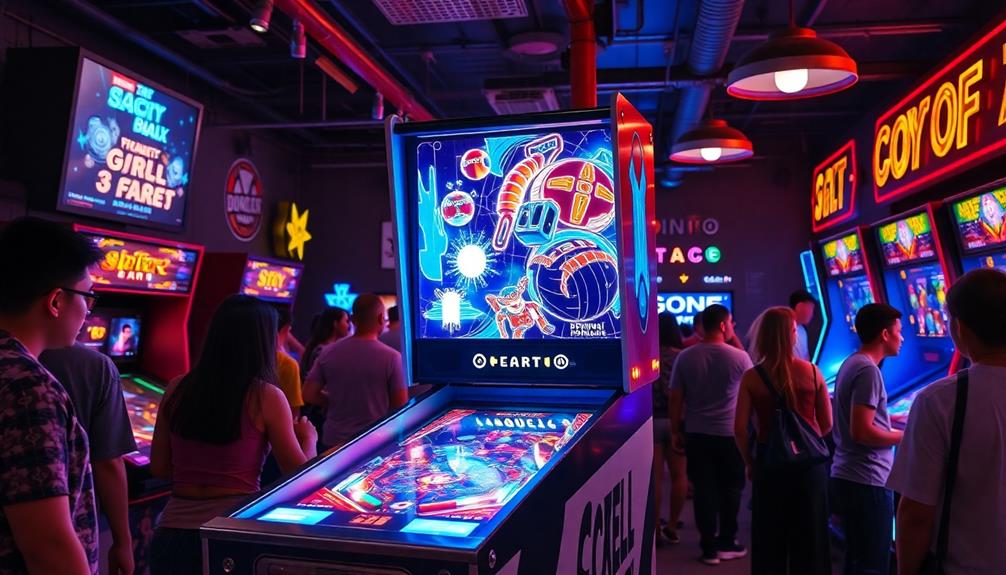
There's a vibrant future ahead for the pinball industry, fueled by a blend of nostalgia and innovation. As you explore this world, you'll notice that interest in pinball machines is surging, thanks to both retro appeal and modern advancements. Independent manufacturers are stepping up alongside established names, creating unique designs that captivate enthusiasts.
Key trends shaping the future include:
- Technological advancements: Large color displays and enhanced sound systems are becoming standard in modern pinball.
- Immersive gameplay: The integration of virtual and augmented reality could revolutionize how you experience the game.
- Collectible value: Themed and artistically crafted machines are highly sought after, appealing to both collectors and casual players.
- Skill sharing: The community fosters events and workshops, ensuring that passion for pinball continues to thrive.
While digital gaming and mobile apps present competition, they haven't diminished the dedication of the pinball community.
With every flip of the flipper, you're part of a movement that blends traditional fun with cutting-edge technology, ensuring pinball remains a beloved pastime for generations to come.
Frequently Asked Questions
How Does a Pinball Machine Work Step by Step?
To understand a pinball machine step by step, you launch the ball, control flippers to hit targets, watch the score on the display, and avoid draining the ball while managing the tilt mechanism for fair play.
What Is the Science Behind the Pinball Machine?
Imagine launching a pinball and watching it zigzag through obstacles. The science behind it involves gravity, forces, and motion, with flippers and sensors manipulating the ball's path, creating a thrilling, interactive experience you can't resist.
What Is Pinball and Why Was It Illegal?
Pinball's a classic arcade game where you launch a metal ball to score points. It was illegal because people viewed it as gambling, often leading to machine confiscations and arrests in cities like New York and Chicago.
How Did Old Pinball Machines Work?
You'd think old pinball machines were just simple toys, but they used springs, solenoids, and electromechanical relays to create complex gameplay. With flippers, you could control the ball and rack up impressive scores.
Conclusion
In the lively world of pinball, you've got a blend of mechanics and strategy that keeps the excitement rolling. As you navigate flashing lights and bouncing balls, you're part of a vibrant history that's continually evolving. While the thrill of the tilt adds a dash of suspense, the future promises even more innovations. So, whether you're an old hand or a curious newcomer, you're bound to find joy in every flip and flipper.
